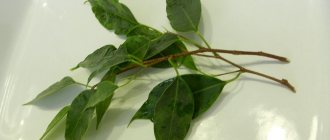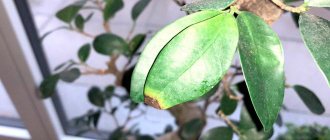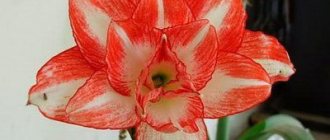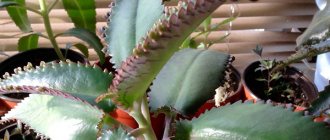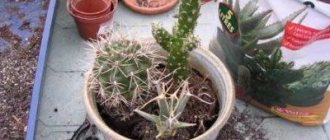Ficus Kinki: home care, photo
Known among gardeners as the fig tree, the houseplant Ficus Kinkiy (ficus kinkiy) is a variety of the ficus flower Benjamin.
Ficus Kinki
Biological characteristics
Ficus flower Green Kinki is a dwarf evergreen variety of the well-known Benjamin, which looks like a tree-like shrub covered with a crown of small (no more than 4 cm long) leaves. Numerous branches fall from the woody, erect trunk.
Translated, the name green kinky means green curly.
The homeland of the ficus Kinki is the West African and Australian tropics, where in natural conditions it grows as a full-fledged tree, reaching a height of 25-30 m.
A distinctive feature in the description of the decorative ficus Benjamin Kinki is the color of its foliage. The edge of the ficus leaves is framed by an uneven stripe of beige and yellow or light green.
The Benjamin flower, despite superstitions and signs, has gained popularity among flower growers due to its small size. Despite its demanding care, this subspecies has taken pride of place in the list of indoor ornamental plants grown at home.
Growing approaches
The growth process and care of the Kinki ficus at home suggests that great importance will be given to creating comfortable conditions for the plant that are most closely similar to the natural germination environment:
- this is a light-loving indoor flower that will actively grow and develop only in sufficiently lit rooms, mainly with diffused light, and not in direct sunlight;
- during the hot period, despite its thermophilic nature, the flower does not tolerate too high temperatures, so the most suitable place for its location will be one that is located far from standard heating radiators and far from artificial heating systems;
- the minimum temperature limit should not be lower than 15°C.
Ficus Benjamin is distinguished by its constancy; the flower does not respond well to moving and replanting. Frequently moving a ficus flower pot can cause the leaves to fall off. Its leaves also fall due to cold drafts.
Humidity levels where the flower grows do not have a strong effect on the plant. It can tolerate both dry indoor air and high humidity. However, maintaining stable conditions will certainly be a positive aspect in caring for a potted flower.
Regular spraying and wiping of its foliage can help protect the ficus from the thermal effects of heating systems.
Care plan
Caring for Ficus Benjamin at home requires regular watering, replanting in case of emergency, and timely feeding.
Watering procedure
For the ficus Kinki, it implies excessiveness and accuracy, since excessive waterlogging of the soil leads to the appearance of fungus, rotting of the plant’s root system and its subsequent death. From small flower pots that are suitable for growing ficus plants, moisture does not evaporate as quickly as from wide containers, so excessive watering can cause its accumulation.
Leaving a ficus for a long time without moisture can also negatively affect the condition of the plant, the leaves of which begin to turn yellow and fall off.
Mineral feeding
Just like when growing and caring for any home flower, when caring for a ficus, one should not forget about mineral supplements. When found in soil depleted over time, a home flower experiences a vitamin deficiency. Simultaneously with the oversaturation of the soil with mineral fertilizers, the plant begins to feel discomfort. In both cases, this leads to leaf fall.
In order to avoid adverse consequences due to a lack or excess of mineralization of the soil in which the Kinki ficus grows, you should care for and fertilize the soil for the plant in accordance with the recommended scheme:
- the time of active feeding occurs at the onset of spring, when, after the end of the winter dormancy, the plant begins to gain growth,
- fertilizing can be carried out before the beginning of the autumn season, after which the flower is not fed, continuing normal care without using fertilizers in the soil,
- To mineralize the soil, complex fertilizers are used no more than 1-2 times per month.
Reproduction methods
Ficus Benjamin Kinki propagates by cutting cuttings or by seeding seedlings. Seed planting, which is better suited to natural conditions, is not recommended by gardeners who are more inclined to propagate by cutting cuttings.
Principles of replanting and pruning
Among the necessary measures in the process of growing and caring for ficus are its replanting and pruning.
Transplantation process
The initial replanting of the plant is required immediately after purchasing an indoor flower, since the substrates in which the plants are sold cannot be constantly grown and must be changed. To replant, you will need a flower pot in which the flower can grow for at least a year, and preferably 2 years.
If you leave the Kinki ficus after purchase in the substrate in which it was sold, the flower will eventually shed its leaves and die.
For initial planting and subsequent flower transplants, it is recommended to choose a ceramic or plastic pot and use soil mixtures specifically designed for growing ficus plants. The basic rule for growing ficus is a pot that is not too big and not too small. When the flower becomes uncomfortable, Benjamin's ficus begins to shed its leaves.
The frequency and frequency of subsequent transplants depend on how much the indoor plant grows and how quickly and intensively its root system grows. Usually, you can replant a ficus by transferring the flower to a new, larger flower pot while preserving the old lump. In such a transplant, only the resulting free space will remain to be filled.
Ficus Kinki. Planting and care. Ficus Benjamin Kinki: care, reproduction, replanting, watering
Pruning rules
It is possible to form the correct crown of the Kinki ficus only by pruning it, which in no way affects the well-being of the indoor color.
The formation of a lush crown can be ensured by planting several shoots of ficus Kinki in one pot. Subsequently, not only the ficus crown will become spectacular, but also their intertwined stems.
In the process of forming the crown, excess leaves and branches are trimmed to give the desired shape.
Source: https://fermoved.ru/tsvetyi/fikus-kinki.html
Possible problems in cultivation and diseases
Even an experienced gardener may encounter difficulties when growing ficus plants. Main problems:
- Leaves fall from the plant. The reason is most likely due to uncomfortable conditions. The temperature may be too high, the watering may be insufficient, or the water may be too cold.
- Attacks of aphids and spider mites. These insects most often attack the plant when the air humidity is too low. The problem is solved by spraying with special means.
- Infectious disease powdery mildew. Infected leaves should be removed, and the remaining ones should be treated with a fungicide solution.
Healthy plant
There are no particular difficulties in growing the Kinki ficus, caring for it and propagating it. You can safely buy it for home so that it brings a little harmony and comfort to your home.
Ficus Benjamin Kinki: home care
Ficus Kinki is a dwarf variety with variegated light green leaves that is a variety of the popular Ficus Benjamin. It is sometimes called Ficus Green Kinky.
A distinctive feature of the ficus is the ability to form a crown and give it any shape, so this evergreen ornamental tree will fit perfectly into any interior and will decorate the apartment.
It is believed that Benjamin Kinki's ficus has good energy , and therefore will delight not only with its beautiful appearance, but also give strength and a charge of positive energy. Read more about the energy of ficus trees here.
Caring for Ficus Kinki
Ficus is easy to care for, but several conditions must be observed:
- The room in which the Kinki ficus will grow should be well lit.
- You need to decide in advance where you will place the plant, so as not to rearrange it in the future.
- It is necessary to ensure timely watering.
- It is necessary to replant the plant on time.
- In the autumn-spring period, fertilizing is required.
If not properly cared for, the ficus will begin to shed its leaves.
Lighting and temperature
The plant needs to be provided with bright, diffused light .
Ficus feels comfortable in an apartment, but it should be noted that the temperature should not be lower than 17 or higher than 30 degrees.
In winter, you need to place it away from radiators, since the plant does not tolerate too high temperatures, and in summer, avoid direct sunlight. In addition, drafts should be avoided.
Watering
Regular watering is required with settled water at room temperature. Do not allow the soil to become overly moist or dry out.
Excessive moisture will lead to rotting of the roots, and if you do not water on time, the leaves will begin to turn yellow or fall off. Watering should be done when the top layer of soil dries a couple of centimeters.
Feeding and soil
Ficus Kinki needs fertile, loose soil, neutral or slightly acidic; it is best to buy a ready-made mixture for palm trees or mulberries in a specialized store.
In the spring-autumn period, from May to October, twice a month, you need to apply mineral fertilizer. In winter, during dormancy, the plant does not need feeding.
Transfer
It is advisable to replant young plants every year; this is best done in early spring.
Adult plants, as a rule, are replanted after two to three years as needed, as soon as it is noticed that the plant has become crowded in the pot.
If you bought a ficus Kinki in a store, you must immediately transplant it into a suitable substrate.
For replanting, you need to choose a container larger than the previous pot. A layer of gravel or pebbles must be placed at the bottom of the container. To replant, you need to remove the plant from the old pot in one lump, without damaging the root system, and transplant it into a larger container.
Details on how to plant, replant and care for the Kinki ficus are described in this video:
Trimming and shaping the crown and trunk
To form a beautiful and lush crown, it is necessary to trim the apical branches so that the side branches grow.
Often Kinki ficuses are planted several in one pot. If two seedlings take root next to each other, you can weave a spiral out of them, or a whole braid out of several, as in the photo below. Until the stems become woody, they are intertwined with woolen threads and so on until the desired height.
It is possible to create even more fancy designs from branches and crowns (see photo):
Another option on how to weave several small ficus plants and trim them is shown in the video:
Reproduction
Reproduction of ficus Kinki is possible in three ways: by seeds; cuttings and pieces of stems.
The easiest and most popular method of propagation at home is by cuttings.
To do this, you need to cut off the top cutting and cut it diagonally with a knife into several leaves and place it in water or wet sand for rooting.
After about two weeks, the cuttings will take root and need to be planted in loose soil.
It is better to cover the plant with a plastic cap at the first stage.
Growing from seeds takes quite a long time and does not always give results.
Diseases and pests
The main diseases include fungal infections, this can be powdery mildew or root rot, which are associated with excess moisture. If you notice a light coating on the leaves, this is powdery mildew.
To treat a plant, it is necessary to cut off all affected leaves and treat the plant with a fungicide. If the roots rot, you need to replace the soil and remove the rotten roots.
Pests of ficus are spider mites, aphids, and scale insects. At the initial stage of the infection, it is enough to wash the ficus in the shower or spray it with a soap solution. In advanced cases, it should be treated with insecticides or fungicides.
If the leaves of the ficus Kinki began to fall, then the reason for this may be:
- moving a plant from one place to another;
- insufficient lighting;
- insufficient watering;
- lack of fertilizers.
As you can see, home care is not that difficult. Ficus Kinki is quite unpretentious, but gives scope for the joy of creativity and creating the shape of a dwarf plant that you want from a ball to an umbrella.
Source: https://prozvety.ru/katalog-rastenij/dekorativno-listvennye/fikus-kinki-uhod-v-domashnih-usloviyah
Ficus Benjamin Kinki: care and maintenance at home
For a long time, ficus has enjoyed deserved popularity among lovers of indoor plants. He deserved such attention thanks to his attractive decorative appearance and simple care at home.
Ficus Kinki is a dwarf form of Ficus Benjamin, which has become a very popular variety of ficus in indoor floriculture.
The flower is native to the tropical regions of Southeast Asia, Australia and West Africa.
It differs from Ficus Benjamin in its miniature size, grace and variegated leaves.
It has another name - fig tree .
It is often used by phytodesigners to decorate residential and office premises, since with proper handling of the flower its crown can be given any shape. Ficus is unpretentious and undemanding in care. The plant tolerates minor mistakes in the care of novice indoor plant lovers.
The plant is a small shrub or tree with straight trunks that are covered with gray bark. The branches of the plant are quite thin and drooping at the ends. The crown is very wide and spreading. The leaves are small, glossy, lanceolate in shape. The leaf length is 3 centimeters.
The surface of the leaf plate is very thin with smooth smooth edges. Along the edge of the leaf blade there is a border of pale green, white or milky color.
The culture contains milky sap that appears at the site of damage to the shoot or leaf.
When kept at home, the shrub does not bloom. In a winter garden or greenhouse, small inflorescences may form that look like berries or balls. The flowers are located deep in the inflorescence and are almost impossible to see. The plant is pollinated by insects that penetrate inside the inflorescence.
Home care
This variety of ficus is undemanding in care and indoor maintenance. Even a novice indoor plant lover can cope with growing a flower. To do this, you should follow simple rules and recommendations of experienced gardeners.
Ficus Benjamin Kinki is a tropical plant, so the flower should be grown in conditions close to natural.
Lighting and location
After purchase, the plant should be immediately placed in a permanent place. Ficus does not tolerate rearrangements and movements, which can cause leaves to fall.
Ficus Benjamin Kinki is a light-loving plant that requires diffused light. It would be optimal to place a flower pot on western or eastern windows.
The plant does not tolerate direct sunlight. In hot weather, the plant should be shaded.
Direct sunlight or insufficient lighting can cause the flower to lose the decorative color of its leaves.
Temperature
Ficus Kinki is thermophilic. For plant growth and development, an air temperature of at least 20 degrees is required. In winter, the room where the flower is kept should warm up to 15 degrees.
Ficus Kinki responds well to ventilation. In warm weather, it can be kept outdoors, but care should be taken to protect the flower from drafts and wind.
Watering the plant and humidity
Care should be taken when watering the Kinki ficus. The soil should not be allowed to become waterlogged. Since the ficus is a miniature plant growing in a small pot, moisture from the surface of the ground evaporates very slowly. As a result of the accumulation of excess water, rotting of the root system and death of the plant can occur.
Watering the flower should be moderate. The soil should not be too dry or waterlogged.
The plant does not have any special requirements for indoor air humidity. Ficus tolerates dry indoor air well. The flower can be periodically sprayed or rinsed under a warm shower, covering the surface of the soil with a plastic bag to prevent waterlogging.
For watering, you should use warm water that has stood for several days or filtered, which does not contain chlorine and other foreign impurities that can cause brown spots to form on the leaves, drying of the leaves and rotting of the roots.
To form the crown of a tree, it is necessary to prune overgrown or dried shoots. We must not forget that the plant secretes a caustic milky sap, which dries out very quickly, so care for the plant should be carried out with gloves using a sharp knife or pruning shears.
If several shoots are planted in one pot, you can form a tree with a lush crown. Over time, the stems will grow together near the base. Hardened shoots can be intertwined with each other, giving the plant a bizarre shape. A single planting can be formed into a miniature bonsai tree.
Transplantation and soil
It is not recommended to replant the plant immediately after purchase. The flower must adapt to new conditions. After 10-14 days, transplant into a looser pot. Plastic or ceramic pots are suitable for ficus.
When planting, the soil is completely replaced with new soil . A ready-made soil mixture for ficus plants is suitable for the flower. You can also prepare the soil composition yourself by mixing leaf soil, coarse sand or perlite, and peat.
The soil for ficus Kinki should be loose, fertile, and well-permeable to moisture and air.
One third of the volume of the pot should be occupied by a drainage layer, for which expanded clay, small crushed stone, broken shards or brick are used.
Transplantation is carried out once every two years . To do this, move the old earthen ball into a new pot and fill the free space with fresh soil. For adult plants, you can limit yourself to replacing the top layer of soil.
Reproduction at home
Flower propagation occurs during the period of active growth. The simplest method of propagation is cuttings.
To propagate ficus, cuttings taken from the top of an adult plant are used. The cuttings are carefully cut with a sharp knife. The length of the cutting must be at least 10 centimeters. Shoots of shorter length take a very long time to take root.
A sticky milky sap forms on the cut of the shoot. After the shoot is cut, it should be rinsed under running water to wash off the juice.
Next, the shoots are dried and planted in small containers filled with nutrient soil. After planting, the container is covered with a glass jar or plastic bag to maintain air temperature and humidity.
The containers are placed in a warm, well-lit place, not forgetting to periodically open for ventilation.
The first roots appear after 10-14 days. After 3 weeks, young plants can be planted in small pots. Care for shoots is carried out as for adult plants.
Top dressing
The application of mineral fertilizers begins in the spring with the beginning of the period of active growth of the ficus. Complex fertilizers are well suited for feeding.
Fertilizers should be applied once every 15 days, from early spring until the end of autumn. In autumn, the frequency of fertilizing is gradually reduced. For plant growth, mineral fertilizers containing nitrogen should be used. However, we must not forget that an excess amount of this component in the soil can cause the flower to lose its decorative leaf color.
Why do the leaves fall
The falling leaves of the Kinki ficus is associated with improper care of the plant at home. There may be several reasons:
- frequent moving of a flower pot from one place to another;
- insufficient lighting, drafts or cold air;
- the period of plant adaptation to new conditions.
Source: https://fikus.guru/komnatnye-cvety-i-rasteniya/fikusy/fikus-kinki-uhod-v-domashnih-usloviyah.html
Flowering and fruiting
The straight trunk of the ficus Kinki is covered with gray bark; the wide spreading crown is formed by thin branches drooping at the ends. The light green lance-shaped leaves are small, glossy, reaching no more than 4 cm in length, their edges are decorated with a border of cream or light green color. In the natural environment and when grown in greenhouses, ficus can form syconia - small spherical inflorescences resembling berries, inside of which there are flowers. The fruits appear only after pollination by insects that penetrate the syconia through a small hole.
Does not bloom at home.
Ficus Kinky: tips for care, propagation and replanting
Ficus Benjamin Kinky ( Ficus Kinky ) is a species distinguished by its small size, as well as the original coloring of its leaves.
This plant arrived in our country from tropical regions, which determined certain requirements for the conditions of its maintenance.
How to properly care for this dwarf tree, what you need to know about watering, propagation and replanting, and what diseases can lead to shedding leaves?
Ficus benjamina, variety - Kinki
This is a houseplant belonging to the mulberry family. It lends itself well to pruning, which allows you to form almost any shape - it is precisely for its decorative effect that the variety has gained wide popularity.
The distinctive features of the Kinki ficus are its height of about 40 cm, woody stem, and unusual leaves - narrow, with multi-colored edges, which seem to be decorated with a green or cream-colored border.
Ideal conditions for this plant are a temperature of at least 20 degrees. Even before bringing the ficus into the house, it is important to determine its future location. This place should be on a slight elevation, since drafts can very quickly destroy a flower - first it will shed all its leaves, after which it will completely wither.
Important! By providing a sufficient amount of light, you need to protect the plant from exposure to direct sunlight.
It is a mistake to think that a capricious tree will actively grow near a radiator - on the contrary, such a heat source will only cause harm. Therefore, in order for the plant to delight its owners with its beauty for a long time, it is necessary to initially choose the right place for it. Any changes are a big stress that will require a further long recovery period.
But air humidity is not a critical parameter - if the leaves are regularly sprayed with a spray bottle, the plant will feel quite comfortable, even in a room with dry air.
Caring for ficus Kinki at home
A significant advantage that the Kinki ficus has over other Benjamin varieties is its ease of care. There are only a few simple rules that need to be taken into account - and the plant will delight its owner for many years to come.
- Watering : Requirements are fairly standard and apply to most Ficus Benjamin varieties. Excessive moisture harms the root system and can cause fungus to develop. The plant needs to be watered only when the top layer of soil has dried a couple of centimeters. But no more, because dry soil, especially long-term, is no less harmful and dangerous.
- Feeding : Ficus Kinki needs regular feeding to saturate the soil with useful substances necessary for normal growth and development. Fertilizer is introduced in the spring according to the standard scheme:
- 1 week - mineral fertilizers
- Week 2 - break
- Week 3 - organic fertilizers
- 4 - break.
The pattern is repeated in a circle until the onset of winter. For indoor flowers, this is a period of rest, during which they do not need additional nutrition.
When introducing fertilizing, it is important to observe the plant’s reaction to such a “treat”. If the leaves turn yellow or begin to fall off, then it is necessary to either change the fertilizer or change its amount. The concentrate is diluted only according to the instructions, otherwise it will cause a lot of harm.
- Transplantation : Young plants change the pot every year - the first time the ficus Kinki is replanted immediately after purchase, after which it is repeated regularly. After 3-4 years, you can reduce the frequency of updating the soil mixture. You need to choose a substrate that is intended specifically for this plant variety.
Important! After transplantation, additional fertilizing is not required, since the new soil already contains all the necessary minerals.
The most important thing is not to damage the root system. For this reason, novice gardeners most often replant the plant along with the old soil, to which the required amount of new soil is simply added.
- Pruning : Beautiful and non-standard shape is one of the advantages in choosing this particular variety. Moreover, the plant tolerates pruning well, and therefore opens up space for non-standard ideas. You can even plant several small trees at once in one fairly spacious pot, weaving the trunks together. Then, as they grow, they will turn into an effective and unusual plant, which can be seen in the photo. When pruning, it is important to reduce manipulation of the main part, working with side branches to create the desired shape.
- Reproduction : Ficus Kinki is not only unpretentious, but also does not cause the slightest difficulty in reproduction. Cuttings are excellent for this purpose, but if desired, you can germinate a new plant from seeds or from a small stem. A suitable cutting is cut from the top of the plant - it should have 2-4 leaves. It needs to be placed in water or wet sand for a couple of weeks - after which the plant can be replanted in the ground.
Ficus diseases and pests
Why ficus sheds its leaves is a question that regularly arises among owners of this indoor shrub. The main reason is improper care of the Kinki ficus. It is important to consider the following rules:
- Room temperature is less than 17 degrees
- Violation of the watering regime
- Lack of lighting
- Draft
- Heat from the battery.
Very often, leaf fall begins even after moving the plant from one place to another. The Kinki variety requires careful and attentive care.
There are 3 types of pests that can pose a danger to this plant. Namely:
- Aphid
- Shchitovka
- Spider mite.
Knowledge of the disease and treatment will help you fight to preserve the plant. It is necessary to prepare a weak soap or alcohol solution, which is used to treat each leaf. This procedure should be repeated every six months, which will be an excellent prevention of possible diseases. If this does not help drive away the pests, then you should choose a suitable remedy designed for effective treatment.
Ficus Kinki is a plant that grows well in almost any conditions, you just need to protect it from drafts and excess light. And then its rich green color will delight its owners for many years to come.
Source: https://fikusdoma.ru/fikus-kinki/
Transfer
Young specimens need annual replacement of the pot and soil; plants older than 4 years need to be replanted every 3–4 years. The optimal time for this procedure is early spring, and the signal for its implementation is:
- overgrown roots visible above the ground or from drainage holes;
- incorrectly selected or depleted soil;
- end of the adaptation period after acquisition;
- presence of pests or disease.
Transplantation should be carried out using the transshipment method, preserving the earthen lump. This method allows you to minimize the likelihood of damage to the root system.
Step-by-step instruction:
- At the bottom of a new plastic or ceramic flowerpot, with a diameter 2–4 cm larger than the previous one, lay a drainage layer of expanded clay, perlite or broken brick and sprinkle it with soil;
- water the ficus;
- take it out of the old pot and place it in the center of the new one, without disturbing the earthen lump;
- fill the free space with a suitable substrate;
- water and fertilize the plant.
Expert opinion
Mokhov Andrey Petrovich
Graduated from KubSAU, specialty: agronomy
Adult specimens whose pot diameter has reached 30 cm do not need to be replanted; it is enough to replace the top layer of soil annually.
Proper care of ficus kinki at home
Ficus Kinki is a miniature variety of Benjamin and belongs to the Mulberry family. Plants of this variety are often found in the form of a bush or low tree. It does not require special care if you follow simple rules for growing it.
Since Kinki is native to the tropics - western Africa, Australia and Asia - it requires near-tropical conditions to grow well.
Shaping the trunk and crown
A distinctive feature of Kinki is its elongated leaves, 3 to 7 cm long, with variegated edges. Moreover, one plant may have leaves with a milky, grayish-white or even light green edge.
A ficus can become a real highlight of the interior if you have patience and give an original shape to its trunk or crown . It is better to do this , when the flower is growing quickly.
Shaping the bonsai crown
When cut, Kinki secretes milky juice. All pruning operations must be carried out with gloves using pruning shears . Before starting work, the instrument is disinfected in an alcohol or manganese solution.
| For weaving ficus | |
| To braid a braid | three young ficus plants with a height of 15 cm or more are enough |
| To weave a spiral | two plants is enough |
To form a trunk, you need to plant several shoots nearby in a pot. The weaving should not be tight to allow the trunks to grow in thickness.
Excess leaves are carefully trimmed , and the weaving points are fixed with woolen threads. As it grows, weaving continues to the desired height.
The crown can be given the appearance of a ball, cone, or umbrella . The cuttings are allowed to grow, after which the excess branches are cut to the desired length and shape. Pruning is done as the ficus grows. By removing excess leaves and branches, directing it in the desired direction and fixing the trunk, you can create many unusual options .
The final result will depend on your imagination and skill.
Branches should be pruned above the bud so that side shoots begin to grow. Then the crown will be lush and take the desired shape.
Few people know that ficus trees are flowering plants . At home, flowers do not form. And in greenhouses small inflorescences appear - syconia, shaped like berries or balls.
The flowers themselves cannot be seen ; they are located inside such inflorescences. The syconium has a small hole through which insects enter for pollination.
Conditions and features of care
Ficus soil, which is sold in flower shops, is perfect for planting the plant. The plant needs to be provided with good drainage . To do this, a layer of expanded clay is poured onto the bottom of the pot, then a layer of sand and soil on top.
Ficus Benjamin Kinki loves good lighting , it is best if the light is diffused.
It is necessary to immediately choose a place for the pot and not move it in order to protect the flower from stress and falling leaves.
The ideal place would be a window sill on the east or west side , protected from direct sunlight. The optimal room temperature is 15-20 degrees.
For normal development, the air in the room should not be dry . Periodically, you should spray the crown with a spray bottle or give the plant a warm shower, covering the soil from moisture.
Make sure that the pot with ficus Kinki is not located near a radiator or in a draft . Hot dry air and cold will negatively affect growth.
Kinki is very picky about watering. This procedure should be performed with settled water at room temperature only when the top layer of soil in the pot dries slightly . If you water too often, the roots may begin to rot. The leaves will fly off due to a long drought.
Watering indoor ficus Kinki
Therefore, it is very important to observe the measure. In the spring, during to add complex fertilizer for variegated indoor plants to the water for irrigation 1-2 times a month
Reproduction and transplantation of homemade Benjamin
The first ficus transplant is carried out after its purchase . The shipping pot and store-bought substrate are not suitable for continuous growth. The planting container should not be too large. For a small cutting, a pot with a diameter of about 10 cm is sufficient.
Later , as it grows, the ficus is replanted using the transshipment method , leaving a lump of old soil around the roots. The resulting voids are filled with fresh soil.
Transferring a flower from one pot to another is best done in early spring . When the diameter of the container reaches 30 cm, in the future it will only be necessary to update the top 3-4 cm of soil annually.
Ficus Kinki propagates by seeds, apical cuttings and pieces of stems . At home, the easiest way is to root a branch about 10 cm long, on which 3-4 leaves are left. Such a shoot can be placed in water or planted in a mixture of soil and sand, covered with a plastic cap on top. The roots appear in 10-15 days .
Diseases and pests: what to do if the ficus begins to shed leaves
Dangerous pests for Kinka are scale insects, spider mites, mealybugs, and aphids . What to do when the ficus begins to lose leaves due to disease? If the plant is infected, you should rinse it thoroughly with warm water in the shower , remembering to cover the soil in the pot.
When this procedure does not help, pest control must be done using store-bought chemicals. A sure sign that your ficus is not liking its environmental conditions is when the leaves fall off . There are many reasons for this. Here are the main ones:
- air temperature below 15 degrees ;
- the flower pot is too close to the radiator or in a draft;
- too much or insufficient watering ;
- the plant has little light ;
- a ficus pot is often moved from place to place .
Excellent ficus specimen
Despite the tropical origin of the ficus Kinki, even a novice gardener can create conditions for it to grow comfortably. It is enough to follow the simple rules described above. And if you approach growing ficus creatively and give it an unusual look, then it will become a real decoration of your home and everyone’s favorite.
Source: https://proklumbu.com/komnatnue/fikus/kinki.html
Watering
The main rule in watering is not to over-moisten the soil, otherwise the flower may die. Ficus Kinki is quite small in size, so the moisture in the pot evaporates slowly. Stagnation of water can lead to rotting of the roots. Watering should be moderate, the soil should not be cracked or wet, like a swamp.
Ficus Kinki has no requirements for air humidity. The plant copes well with dry air.
It is recommended to periodically remove dust from the leaves with a damp sponge and give the flower a warm shower once every 3 months.
The most obvious advantage of such a variegated tree is its relative unpretentiousness. Caring for the Kinki ficus at home consists primarily of timely watering.
Soil and fertilizing
The soil should be loose and fertile. At a flower shop you can purchase ready-made soil for ficus plants or create a substrate yourself. To prepare the substrate you need to take the following components:
- peat (1 part);
- leaf soil (1 part);
- sand (1 part);
- drainage from small stones.
Over time, any soil becomes depleted, and it is necessary to fertilize the Kinki ficus between March and September. It is necessary to feed the flower during active growth with complex and mineral fertilizers. Usually the flower is fertilized once every 30 days.

